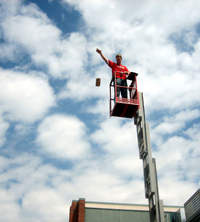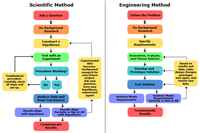New Science Standards Emphasize the Engineering Design Process
The Next Generation Science Standards encourage a multi-dimensional view of science education, one that highlights the importance of students learning to use the engineering design process—as well as the scientific method.

Science and Engineering Methods Side by Side in Next Generation Science Standards
A classic physics activity challenges students to discover how to keep an egg from breaking when dropped from a certain height. Using the scientific method, a student may initially hypothesize that the egg will break! Subsequent variations of the hypothesis might posit that x material will provide better shock absorption than y material. An experimental procedure is then established to test.
Using the engineering design process, students accept that the egg will break unless a solution is devised to protect it. Students then move on to brainstorming, prototyping, testing, and refining a solution created specifically to meet the need—and protect the egg. (Image: Wikipedia.)
Central to the NGSS is new attention to the importance of familiarizing students with the engineering design process—and giving them opportunities in which to use the engineering design process (or engineering "method") as a way to apply science, technology, engineering, and math to challenges or problems. The NSTA summarizes the NGSS this way: "The Next Generation Science Standards (NGSS) establish learning expectations for students that integrate three important dimensions—science and engineering practices, disciplinary core ideas, and crosscutting concepts—effectively builds science concepts from kindergarten through 12th grade, and integrates important concepts of engineering."
The engineering design process is, of course, not new. Within certain fields, principles of the engineering design process are critical to everyday exploration, research, and invention, and countless examples of innovation and discovery throughout history have roots in the engineering design process. What is new, however, is a national educational approach that calls for making room for a design process that helps blueprint innovation alongside the traditional scientific method that seeks an answer to a science question based on testing. Cohabitation of these methods will have broad impact for many classrooms and science fairs that have not, to date, integrated, encouraged, or allowed student engineering design projects. (See the gray box at the bottom of this post for links to helpful Science Buddies Teacher Resources!)
Similar but Different
While both involve a series of somewhat systematic steps, the scientific method and the engineering design process use different sets of steps. The methods resemble one another in that they offer steps which help guide and order exploration or inquiry, but as many students and teachers have discovered, a student's engineering design project cannot always be easily squished into the steps of the scientific method either during the procedure or for the purposes of judging. It is and has been done, yes. Not all science fairs, for example, make specific allowances for engineering design projects, which has left students creatively adapting their engineering project steps and data to fit the scientific method model. With the advent of the NGSS and new validation of the importance of teaching engineering design as a critical "practice" for all students, regardless of whether or not they will pursue fields in science and engineering, ramping up for broader integration of engineering design will be important.
In explaining the "practices" dimension, authors of the NGSS specifically highlight the importance of both methods—and their differences. "Although engineering design is similar to scientific inquiry, there are significant differences. For example, scientific inquiry involves the formulation of a question that can be answered through investigation, while engineering design involves the formulation of a problem that can be solved through design."
By learning to use the separate scientific and engineering "practices," students will be better able to approach a broad range of real-world challenges. In many cases, brainstorming solutions to an engineering challenge requires creative thinking and both the ability and the confidence to think outside a prescribed set of parameters—the proverbial "box." A solution often lies in the pursuit of a new approach that answers a need in a completely new way, or maybe answers in a way that is only slightly different but enough different to have an important or measurable effect. Solving some science problems requires the ability to think independently, to synthesize core principles, and then to find a way to apply (or account for) those principles. Solving many of today's—and tomorrow's—problems will require an engineering mindset, and it is this reality that underlies the weight given to engineering methods in the NGSS.
Unfortunately, in some science education classrooms and settings, creative and innovative thinking has been kept to the periphery, often by necessity. The relationship between curriculum requirements and testing has not always left room for hands-on learning or for learning where different answers and different solutions can be encouraged. Instead, in order to prepare students to fill in the correct circles on standardized tests, there are often rote exercises and labs that students work through, exercises that may pass as active learning. By fulfilling a series of prescribed steps, students see an outcome, but deviating from the steps is not always encouraged, and troubleshooting when something goes wrong is not always required. Approached in this way, hands-on science runs the risk of becoming narrow, linear, and prescribed.
What about all the accidents that led to scientific discovery and breakthrough? What about the fact that changing a single variable might dramatically alter the results of an experiment? What about the questions that arise from the basic test, the "what if" that comes rushing to the surface for an engaged student who wants to take an experiment to the next level?
With the NGSS and the emphasis on multiple dimensions of learning, students may find more latitude for thinking creatively and learning how to apply creativity to science and engineering problems. But there will be many new questions for administrators and teachers. How will science fair requirements change for engineering design projects? How should engineering design projects be graded? What do students conducting an engineering design project turn in?
Science Buddies Resources for Science Education
The "Comparing the Engineering Design Process and the Scientific Method" resource is one of many tools at Science Buddies designed to support teachers as they include both science and engineering projects in their curriculum and planning.
While engineering design shifts focus to innovation, improvement, and problem solving, the method helps guide students in a series of successive steps that include research, brainstorming, prototyping, testing, data analysis, and documentation. The difference is that there is often iterative looping at points in the method as students prototype, test, and then go back and make changes to the design, prototype again, and retest.
In the engineering design process, troubleshooting is not an action that happens when a procedure is not performing as expected; troubleshooting, instead, is a process of determining in what ways a design is not meeting the specified requirements and brainstorming and evaluating ways to modify the design to better address the need and as a result of testing and evaluation of a previous design. Students working on engineering design projects may begin not with a question but with a problem and are asked to simultaneously think creatively and analytically as they search for and test possible solutions.
The Egg Drop: A Classic Exercise
A classic physics assignment requires students to design a solution that will allow an egg to be dropped from a certain height without breaking. The parameters, including the acceptable materials and the height of the drop, waffle from teacher to teacher, but the general concept of the challenge is the same—you have to protect your egg. Your goal is to protect the egg from breaking when dropped from a given height. The problem involves the fact that an egg will break upon impact when dropped from a given height to a hard surface. Understanding and addressing the problem involves synthesizing knowledge about the physics of gravity, free fall, velocity, and acceleration. Add in materials science factors of elasticity, stress, and shock absorption, and you have the makings of a great interdisciplinary and hands-on exploration.
Can you do anything about it?
What principles of physics come into play?
Is there a way to change the egg's outcome?
What real-world scenarios present similar challenges?
It takes engineering know-how and an understanding of the laws of physics to prototype a solution. But devising an innovative approach to protecting an egg from the combined effects of gravity and impact with a hard landing surface also requires the ability to think creatively. There is no single workable solution to protecting the egg. Instead, many approaches may work. What approach will work best? And why? These are the kinds of questions students ask and think through when selecting a design to prototype.
In asking these questions and designing a solution, students employ the engineering design process. The standard steps of the scientific method provide an ill-fitting rubric for this kind of investigation. The engineering method, on the other hand, offers a map students can follow as they work through the process. What materials will work? What are the benefits of different materials? Does the solution need to fall within a certain price point? How much protection is "too much"? Even when conducted as a short (10-15 minute) in-class challenge with limited materials by individuals or collaborative teams, the engineering method helps students focus the design process as they move from problem to solution. Although in some competitions, testing the prototype is not allowed until the end where it is, truly, a make or break demonstration!
And what happens if the egg breaks? The information and data from the testing can be funneled back into the process for subsequent revisions to the design, prototyping, and re-testing.
From Protecting Eggs to Solving Problems Today and Tomorrow
The challenge as teachers and schools begin adopting and implementing NGSS will be to encourage students to think conceptually about a wide range of problems encountered in the real world, from the need to package fruits in a way that reduces bruising during transport to new designs for more full-featured and comfortable prosthetic limbs; new designs for artificial organs, and other life-saving medical devices; innovations in battery technology to efficiently store green but cyclic energy like solar and wind power; and designing inexpensive and effective carbon sequestration techniques. With the right framework at hand, and familiarity with following steps for both science and engineering projects, what today's students will discover, solve, prove, and create tomorrow is unlimited.
In support of the inclusion of engineering design projects in science fair competitions, Science Buddies Teacher and Science Fair Resources include tools and materials to help students incorporate both the scientific and engineering methods in their classrooms.
See the following resources:
- "Understanding the Engineering Design Process: Teachers Embracing Engineering Design"
- "Comparing the Engineering Design Process and the Scientific Method"
- "Engineering Project Judging Scorecard" (downloadable from the Science Fair Resources page)
- "Science Project Judging Scorecard" (downloadable from the Science Fair Resources page)
- "Science Projects mapped to NGSS Core Teaching Standards" (downloadable from the Teacher Resources page)
Categories:
You Might Also Enjoy These Related Posts:
- Rubber Band Car Challenge Entries Cross the Finish Line!
- Tenth Annual Science Buddies Engineering Challenge Revealed
- 2023 Engineering Challenge Sees Record Participation
- Ninth Annual Science Buddies Engineering Challenge Announced with Support from EPAM Systems
- Best of STEM Resources in 2019
- Polymers Project Gets a Slime Update
- New Series of Science Buddies Books
- Science Buddies Annual Report: Supporting STEM Education










